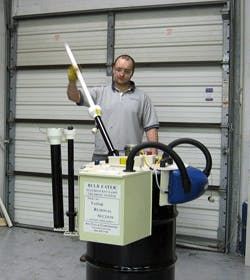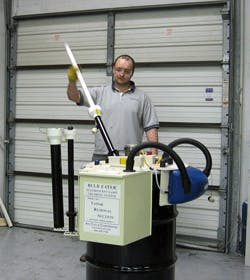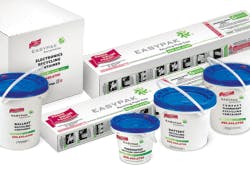Recycling Fluorescent Lamps: It Can Be Affordable and Easy
Does your facility have fluorescent lights?
Because they contain mercury, spent fluorescent lamps increasingly cannot be trashed in dumpsters as a solid waste. This is a major challenge for facilities across the country since nearly every facility uses them and over 650 million lamps are disposed each year.
Mercury is linked to severe health issues such as blurred vision, numbness in limbs, speech impairment, severe convulsions, developmental problems, loss of consciousness, insanity, birth defects, possible autism, and more. A single four-foot fluorescent tube contains from five to 50 milligrams of mercury. When conventional disposal methods are used, mercury vapors can travel over 200 miles. Hence, the Environmental Protection Agency (EPA) regulates fluorescent lamps and stipulates strict guidelines for their disposal.
Facilities that do not comply with these regulations not only bring harm to the environment, they risk costly restitution. In fact, if fluorescent lamps are found in landfill sites and traced back to the offending parties, they can be penalized with the cost of the landfill cleanup, in addition to any other fines levied. Hence, it greatly benefits companies and institutions to adhere to EPA guidelines and dispose of fluorescent lamps appropriately.
Many companies have found such disposal to be both labor and cost intensive, but have endured the burden in an effort to remain compliant. These hurdles have caused the marketplace to develop new methodologies. As a result, fluorescent lamp disposal is far easier and less costly than ever before.
Prior to coming across these new methods, Sheela Backen, Integrated Solid Waste Program Manager at Colorado State University, had to supervise a complex and costly method of fluorescent lamp disposal-packing used lamps back into original cartons and loading them onto a truck. The truck would then transport the lamps to a recycling facility.
"That method presented a lot of problems," Backen says. "We couldn't get people to make sure the cartons were full, taped and marked with the date. When the truck was coming to pick them up, we would have anywhere from six to eight people filling boxes, taping them back up, and then loading this truck. It was not cost-effective at all."
This OSHA and EPA-compliant machine crushes over 1,000 fluorescent lamps (amount depends on size of lamps) and packs them into a 55-gallon drum. The process is fully enclosed and filtered, so that the glass, aluminum, and harmful vapors are contained. When full, the drums are picked up and transported to an EPA permitted lamp recycling facility where the contents are separated, treated, and ultimately reused. Backen utilizes their easy-to-use online scheduling to arrange the drum pickup, and has been able to reduce the needed labor from six to eight personnel down to one.
"The cost of shipping a truckload of boxed tubes is a whole lot more than shipping a drum of crushed tubes," Backen adds. "That was another cost-effective factor that we were looking at when we bought this machine."
Mark Funkhouser, Custodial Services Manager with The Chumash Casino Resort in Santa Ynez Valley, California, was having similar problems disposing of fluorescent lamps. His method was through a local waste hauler, who would remove the lamps in bins.
"It required a lot of attention," Funkhouser says. "It required labor because we had to pack the bulbs in different kinds of bins and place them wherever the truck pickup was going to be. We also were never sure of the outside contactor's schedule, so we really didn't know when he was going to come."
Funkhouser then found a removal method online that greatly reduced the attention and labor-a pre-paid recycling program, called EasyPak. "EasyPak is a great system because we can just put the box in a corner of the warehouse, and then as the engineers bring the bulbs back, they put the bulbs in the box and it's ready for shipping. When it gets full, we just close up the top, stick a label on the box and ship it off and our part is done. It's definitely reduced our labor."
This prepaid service allows lamps to be shipped in custom-made secure containers, via FedEx Ground, to licensed recycling facilities-a program Funkhouser and his department have found very convenient and cost-effective. The program also provides online access to recycling certificates, shipment tracking, and ordering replacement containers. Orders can even be set up for new containers to ship automatically as full containers are received at the recycling centers.
Both Backen and Funkhouser have found their recycling company to be very accommodating of their individual fluorescent lamp disposal needs. Backen is especially conscious of which recycling company is being used. This company has allowed her to specify destination recycling companies based on her own research of current EPA ratings and licensing. Funkhouser is happy that a company rep contacts him whenever they place an order to ensure they're getting the right amount of the correct containers, and to see if they need anything else. Recycling Certificates can be automatically sent to Funkhouser so he knows the bulbs were indeed recycled.
Funkhouser also has the periodic need for recycling batteries and ballast, which he is able to handle through the same EasyPak program, giving him one source for his needs.
The decision of which type of service to use is dependent on the facility size and the quantity of lamps needing disposal. "A facility totaling over 200,000 square feet in size is a great candidate for the Bulb Eater®, especially when they have limited storage space," says Scott Beierwaltes, CEO of Air Cycle. "Smaller facilities are typically more attracted to a pre-paid program like EasyPak. They want the same convenience, but usually don't generate enough lamps to justify a Bulb Eater®."
Finally, the expensive necessity of proper fluorescent lamp disposal has been made less tedious and far more cost-effective.
For more information about the Bulb Eater, contact Air Cycle at (800) 909-9709 or http://www.AirCycle.com. For more information about the pre-paid EasyPak program, call (888)640-6700 or go to http://www.lamprecycling.com.Bruce Boyers is a freelance writer based in Glendale, California


